If ever there was a love/hate relationship, it’s with vines. Some people hate them while others think they’re pretty cool. I’m in that latter category.
I like to know something’s value before I categorically pluck it out of the soil. It’s no different with vines. I try to research what they’re all about.
It isn’t enough to be content with rambling vines appearing on their own. Several years ago, I purposefully dedicated a partially dead mesquite tree as a “natural” trellis for climbing milkweed (Funastrum cynanchoides).
Neither I nor the vine caused the tree’s semi-deceased state, so I didn’t think the tree would mind supporting this gentle life form. The vine did a great job. It traveled up the trunk and veered off in the appropriate direction.
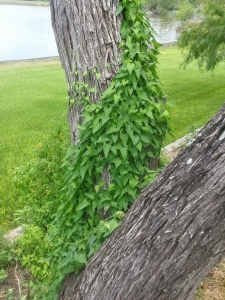
Lovely globes of pink-edged white blooms peppered the vine in summer.
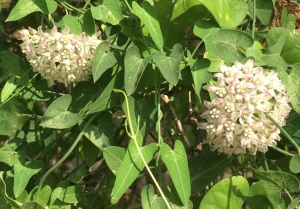
Later, flowers turned into dangling fleshy spears, like green Christmas tree ornaments.
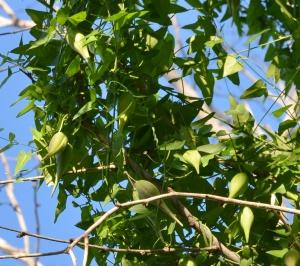
Eventually those split open, loosening their helicopter-like seed-transporting fluff. Fortunately, the wind generally blows in the right direction and carried the thousands of seeds toward the resaca, not back to other garden beds.
I say fortunately because climbing milkweed is tremendously prolific.
In Harlingen’s Hugh Ramsey Park, it can cover entire bank-sides along the lower track of the Upper Arroyo Trail if allowed.

Yes, the leaves are important to monarch and queen caterpillars; one vine will feed plenty, so don’t judge me for not promoting the proliferation of climbing milkweed at my home.
Let me interject a bit of back-story here for the next lovely vine I want you to know about. Shortly after being certified as a Texas Master Naturalist, I began noticing plants around the property — as all TMN neophytes do, of course. Enter a wee bunch of attractive, fleshy-looking, small, heart-shaped leaves, of what I thought for several years, to be an ever-present, self-contained ground plant.
A Berlandier trumpet (Acleisanthes obtusa) had staked a claim in a crack near the edge of the driveway. I’ve since found Berlandier trumpet plants hanging from gaps in the retaining wall and edges of the driveway.

Richardson/King, Plants of Deep South Texas, page 326, IDs Berlandier trumpets as vine four o’clock, further enforcing one of the first tenets of biological nomenclature — always ID plants with both common and scientific name.
If you’re not familiar with this plant, they’re lovely. Really, quite polite and they don’t aspire to take over small buildings, docks or cabanas.
The flowers are beautiful. Clumps of small trumpet-like white blooms. What’s really cool is that the filaments and anthers are pink, making the white petals look to have a spill of pink polka-dots!
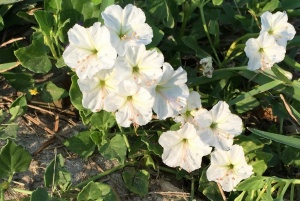
However, unbeknownst to me, a Berlandier trumpet had made its way to the base of my vine tree. Judging by the length of the vine-like stem — it had quietly been vining up the tree, along with the milkweed, for quite some time. It was the first I realized that it was a traveling vine and not just a polite clump.
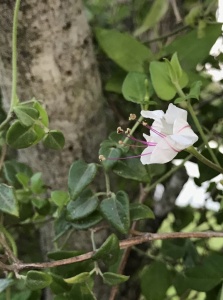
I only discovered it because I was out early enough one morning and saw the night-blooming trumpets just beginning to close in the morning’s light. I compared the blooms and leaves with the plant at the driveway edge.
Some vines hook themselves to supports thigmotropically while others meander along the ground, through shrubs and bushes and over brushy pasture plants. Berlandier Trumpets and climbing milkweed are of the latter type.
What’s really exciting about Berlandier trumpets is that the happy trumpets will greet you all year long as they bloom in all seasons. Plants of Deep South Texas has a romantic idea about the night-blooming plant — it says, “The flowers are best when seen on a moonlit night!” If you’ve kept up with my blog, please recall that night-blooming plants are great targets for pollinating moths!
Lastly, let me mention one of my favorite vines, common balloon vine (Cardiospermum halicacabum). It thigmotropically hooks tendrils onto a support, such as a chain-link fence.
I liked it from the start because of its name — I mean, who doesn’t like balloons, right?
It’s especially fun this time of year because the balloons turn cinnamon-colored and pretend they’re tiny little pumpkins. Or fall-festive Japanese lanterns dangling in the garden.

I was introduced to balloon vine on a summer seed collecting venture in Ramsey Park. Since then, one keeps coming up in the park’s Betty McEnery Memorial Garden. Several times I would pocket a seed or two and plant it along the fence at home. Nothing ever came of those attempts.
This spring, while we were clearing overgrowth from the McEnery garden, I spied an errant cluster of tiny leaves. I compared the leaves with the adult balloon vine a few yards away and then rescued the vine sprig from certain trampling death as we worked to maintain the area.
At home, I planted the wee vine along a section of fence in full sun where it would also catch regular watering from an irrigation head. Success ensued.
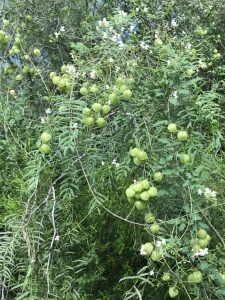
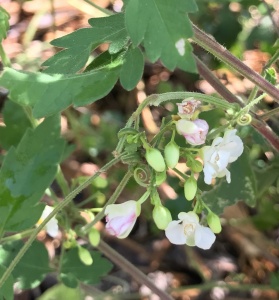

Common balloon vine blooms all seasons. More nectar opportunities for winter-lingering butterflies.
The fruit is chambered and tissue-paper-thin when dry. There are usually two round black seeds in each pod. The seed has a white tip.
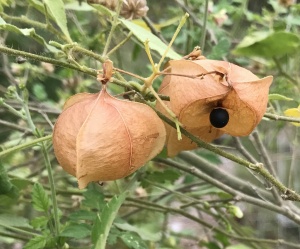
Many of the pods will be empty. If you look at the skin closely enough, you’ll find a bug hole. Those seeds that escape the insects and make it safely to the ground are excellent Bob-white quail food — which is why I’ve been keen to grow this vine on our property along the fence.